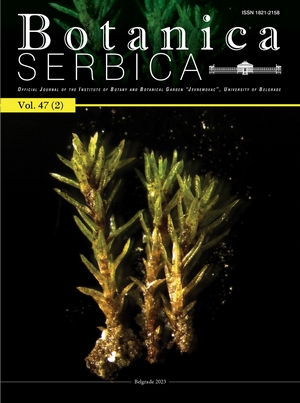
Volume 47 Issue 2 2023 |
Ferulago brachylobae-Daucetum setifolii J. López-Tirado, ass. nova from
southern Spain
|
KEY WORDS: aestival plants, Daucus setifolius, Ferulago brachyloba, new association, southern Spain, vegetation. |
Modelling the distribution of the Caucasian oak (Quercus macranthera) in
Western Asia under future climate change scenarios
|
KEY WORDS: CMIP6, global warming, potentially suitable habitat, random forest, species distribution models |
The seed germination properties of two hyperaccumulator plant species with
the potential for Ni agromining
|
KEY WORDS: ultramafic, nickel, serpentinophytes, germinability, seed storage, Bornmuellera |
A new species of Circinaria (Pertusariales, Megasporaceae) from Pakistan
|
KEY WORDS: Ganga Choti, Khyber Pakhtunkhwa, phylogenetic relationships |
The antibacterial activity of culture filtrates and mycelia of selected strains of
macromycetes from the genus Hericium
|
KEY WORDS: antibacterial action, basidiomycetes, culture filtrate, mycelium |
The distribution of alien species Geranium sibiricum in Slovakia
|
KEY WORDS: Central Europe, chorology, introduction, neophyte, Siberian Cranesbill, spreading, synanthropic habitats, traffic |
Optimising in vitro culture conditions for the truffle Tuber brumale
|
KEY WORDS: growth medium, hyphal branching, hyphal extension, mycelium, winter truffle |
Elicitors enhanced the production of bioactive compounds in shoot cultures of Hypericum amblysepalum
|
KEY WORDS: Hypericum amblysepalum, jasmonic acid, methyl jasmonate, shoot culture. |
The complete chloroplast genome sequence of Rhododendron fortunei: structural comparative and phylogenetic analysis in the Ericaceae family
|
KEY WORDS: Rhododendron fortunei, nextgeneration sequencing, chloroplast genome, comparative genomics, conservation genetics |
An insight into the variation of the antioxidative and antibacterial activity of extracts from populations of the subalpine and montane lichen Cetraria
islandica
|
KEY WORDS: agar diffusion method, DPPH assay, montane zone, phenols, secondary metabolites, subalpine zone |
Arable bryophytes from Northeastern Slovenia with new and interesting national records
|
KEY WORDS: Slovenia, flora, arable, mosses, liverworts, new national report, Red List |
Expression of heavy metal ATPases (HMA1 and HMA3) in Brassica nigra and B. juncea grown at different Cu levels
|
KEY WORDS: metal toxicity, gene expression, metal transporters, phytoremediation |
Proteome response of winter-hardy wheat to cold acclimation
|
KEY WORDS: antioxidant, freezing tolerance, glycolysis, photosynthetic, proteomics, cold-responsive proteins |
Physiological responses of bread and durum wheat seeds to osmotic stress and salinity in the early germination stage
|
KEY WORDS: salinity, osmotic stress, germination, wheat, reactive oxygen species, compatible solutes |
New combination and typification of Tanacetum parthenium var. flosculosum (Asteraceae) and its first record from Turkey
|
KEY WORDS: Asia, feverfew, neotype, new record, nomenclatural change |
New records and noteworthy data of plants, algae and fungi in SE Europe and
adjacent regions, 14
|
KEY WORDS: new report, Acrocordia subglobosa, Alessioporus ichnusanus, Amanita mairei, Buxbaumia viridis, Callitriche brutia, Callitriche platycarpa, Chara connivens, Cyclostephanos invisitatus, Cyclotella meduanae, Diaporthe oncostoma, Epilobium nutans, Epipactis pontica, Gymnadenia frivaldii, Orchis italica, Pseudomassaria chondrospora, Stephanodiscus lacustris, Stropharia albonitens, Tortella fasciculata, Tortula protobryoides, SE Europe |
New records and noteworthy data of plants, algae and fungi in SE Europe and
adjacent regions, 15
|
KEY WORDS: new report, Amanita friabilis, Callitriche cophocarpa, Calypogeia integristipula, Campylopus introflexus, Chara hispida, Cornus sanguinea subsp. hungarica, Dicranum transsylvanicum, Epipactis exilis, Epipactis purpurata, Epipogium aphyllum, Geastrum morganii, Guignardia istriaca, Hypoxylon howeanum, Ophioglossum vulgatum subsp. vulgatum, Ricciocarpus natans Suillus americanus, Tortella pseudofragilis, Trematodon ambiguous, Vaucheria frigida, Viscum album subsp. austriacum, SE Europe |


